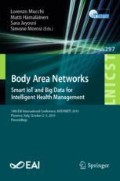Abstract
In response to the demand of memory efficient algorithms for electrocardiogram (ECG) signal processing and anomaly detection on wearable and mobile devices, an implementation of the antidictionary coding algorithm for memory constrained devices is presented. Pre-trained finite-state probabilistic models built from quantized ECG sequences were constructed in an offline fashion and their performance was evaluated on a set of test signals. The low complexity requirements of the models is confirmed with a port of a pre-trained model of the algorithm into a mobile device without incurring on excessive use of computational resources.
This work is supported by JSPS KAKENHI Grant Number JP17K00400.
Access this chapter
Tax calculation will be finalised at checkout
Purchases are for personal use only
References
Dias, D., Paulo Silva Cunha, J.: Wearable health devices—vital sign monitoring, systems and technologies. Sensors 18(8), 2414 (2018)
Crochemore, M., Mignosi, F., Restivo, A., Salemi, S.: Text compression using antidictionaries. In: Wiedermann, J., van Emde Boas, P., Nielsen, M. (eds.) ICALP 1999. LNCS, vol. 1644, pp. 261–270. Springer, Heidelberg (1999). https://doi.org/10.1007/3-540-48523-6_23. https://hal-upec-upem.archives-ouvertes.fr/hal-00619991/document
Ota, T., Morita, H., de Lind van Wijngaarden, A.J.: Real-time and memory-efficient arrhythmia detection in ECG monitors using antidictionary coding. IEICE Fundam. E96–A(12), 2343–2350 (2013)
Frias, G., Morita, H., Ota, T.: Anomaly detection on quantized ECG signals by the use of antidictionary coding. In: Proceedings of the 41st Symposium on Information Theory and its Applications, December 2018
Rajni, R., Kaur, I.: Electrocardiogram signal analysis - an overview. Int. J. Comput. Appl. 84(7), 22–25 (2013)
Mayo Clinic: Premature ventricular contractions (PVCs), February 2018. https://www.mayoclinic.org/diseases-conditions/premature-ventricular-contractions/symptoms-causes/syc-20376757
ECGwaves.com: Premature Ventricular Contractions (premature ventricular complex, premature ventricular beats): ECG and clinical implications (2018). https://ecgwaves.com/premature-ventricular-contractions-complex-beats-ecg/
Ota, T., Morita, H.: On-line electrocardiogram lossless compression using antidictionary codes for a finite alphabet. IEICE Trans. Inf. Syst. E93–D(12), 3384–3391 (2010)
Zhao, Z., Zhang, Y.: SQI quality evaluation mechanism of single-lead ECG signal based on simple heuristic fusion and fuzzy comprehensive evaluation. Front. Physiol. 9, 727 (2018)
Tziakouri, M., et al.: Classification of AF and other arrhythmias froma short segment of ECG using dynamic time warping. In: Computing in Cardiology, vol. 44, pp. 1–4 (2017)
Moody, G.B., Mark, R.G.: The impact of the MIT-BIH arrhythmia database. IEEE Eng. Med. Biol. Mag. 20, 45–50 (2001)
Goldberger, A.L., Amaral, L., et al.: PhysioBank, PhysioToolkit, and PhysioNet: components of a new research resource for complex physiologic signals. AHA - Circulation 101(23), E215–20 (2000)
Ittatirut, S., Lek-uthai, A., Teeramongkonrasmee, A.: Detection of premature ventricular contraction for real-time applications. In: 2013 10th International Conference on Electrical Engineering/Electronics, Computer, Telecommunications and Information Technology, pp. 1–5, May 2013. https://doi.org/10.1109/ECTICon.2013.6559531
Adnane, M., Belouchrani, A.: Premature ventricular contraction arrhythmia detection using wavelet coefficients. In: 2013 8th International Workshop on Systems, Signal Processing and their Applications (WoSSPA), pp. 170–173, May 2013. https://doi.org/10.1109/WoSSPA.2013.6602356
Alajlan, N., Bazi, Y., Melgani, F., Malek, S., Bencherif, M.A.: Detection of premature ventricular contraction arrhythmias in electrocardiogram signals with kernel methods. Sig. Image Video Process. 8(5), 931–942 (2014). https://doi.org/10.1007/s11760-012-0339-8
Espressif Systems: Esp32-wroom-32 datasheet. https://www.espressif.com/sites/default/files/documentation/esp32-wroom-32_datasheet_en.pdf
Espressif Systems: Repository: Arduino core for esp32 wifi chip. https://github.com/espressif/arduino-esp32
The Bluetooth Special Interest Group (Bluetooth SIG): GATT services. https://www.bluetooth.com/specifications/gatt/services
Author information
Authors and Affiliations
Corresponding author
Editor information
Editors and Affiliations
Rights and permissions
Copyright information
© 2019 ICST Institute for Computer Sciences, Social Informatics and Telecommunications Engineering
About this paper
Cite this paper
Frias, G., Morita, H., Ota, T. (2019). Arrhythmia Detection with Antidictionary Coding and Its Application on Mobile Platforms. In: Mucchi, L., Hämäläinen, M., Jayousi, S., Morosi, S. (eds) Body Area Networks: Smart IoT and Big Data for Intelligent Health Management. BODYNETS 2019. Lecture Notes of the Institute for Computer Sciences, Social Informatics and Telecommunications Engineering, vol 297. Springer, Cham. https://doi.org/10.1007/978-3-030-34833-5_5
Download citation
DOI: https://doi.org/10.1007/978-3-030-34833-5_5
Published:
Publisher Name: Springer, Cham
Print ISBN: 978-3-030-34832-8
Online ISBN: 978-3-030-34833-5
eBook Packages: Computer ScienceComputer Science (R0)

